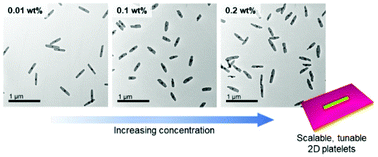Towards scalable, low dispersity, and dimensionally tunable 2D platelets using living crystallization-driven self-assembly†
Abstract
Nanoscale two-dimensional (2D) rectangular platelets based on polymeric precursors are of interest as a result of their potentially useful properties and applications. Low dispersity 2D platelets can be prepared from crystallizable polymeric amphiphiles via the seeded growth method known as living crystallization-driven self-assembly (CDSA) but only at very low solution concentrations of ca. 0.002–0.01 wt%. This severely limits the ability to explore their properties in detail and to investigate new applications. In this proof-of-concept work we report significant improvements in the scalability of low dispersity 2D nanoparticles prepared via living CDSA of phosphonium-capped poly(ferrocenyldimethylsilane) (PFS) homopolymers, PFS23[PPh2Me]X, with surfactant counteranions (X−) at concentrations up to 0.2 wt%, 20 times higher than previously reported. At higher concentrations, platelets are still formed but at the cost of a loss in fidelity. The effects of different counteranions, temperature and concentration on platelet dimensions, structure fidelity, and aggregation behaviour were also explored. Moreover, increasing the temperature at which self-assembly was performed was found to improve the platelet fidelity and yield lower aspect ratio structures at high concentrations.

- This article is part of the themed collection: #RSCPoster Conference


 Please wait while we load your content...
Please wait while we load your content...